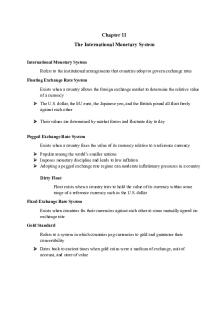Chapter 9 - Poltak lecture PDF

| Title | Chapter 9 - Poltak lecture |
|---|---|
| Author | christine cl |
| Course | Human Anatomy & Physiology |
| Institution | University of New Hampshire |
| Pages | 3 |
| File Size | 47.4 KB |
| File Type | |
| Total Downloads | 51 |
| Total Views | 127 |
Summary
Poltak lecture...
Description
An Introduction to Joints ● Joints (articulations) ● Where two bones meet ● Where body movement occurs ● A tradeoff exists between strength and mobility ● Two classification schemes ● Structural (anatomy) ● Functional (range of motion) ● Joint structure determines function 9-1 Classification of Joints Structural classifications ● Fibrous ● Cartilaginous ● Bony ● Synovial Functional classifications ● Synarthrosis (immovable joint) ● Amphiarthrosis (slightly movable joint) ● Diarthrosis (freely movable joint) Synarthrosis (immovable joint) ● Very strong ● Edges of bones may touch or interlock ● May be fibrous or cartilaginous ● Four types of synarthrotic joints ○ Suture ○ Gomphosis ○ Synchondrosis ○ Synostosis Synarthrosis Suture ● Found only between bones of skull ● Edges of bones interlock ● Bound by dense fibrous connective tissue Gomphosis ● Binds teeth to bony sockets ● Fibrous connection (periodontal ligament) Synarthrosis
Synchondrosis ● Rigid cartilaginous bridge between two bones ● Found between vertebrosternal ribs and sternum ● Also, epiphyseal cartilage of growing long bones Synostosis ● Created when two bones fuse ● Example: metopic suture of frontal bone ● And epiphyseal lines of mature long bones Amphiarthrosis ● More movable than a synarthrosis ● Stronger than a diarthrosis ● May be fibrous or cartilaginous ● Two types of amphiarthroses ● Syndesmosis—bones connected by a ligament ● Symphysis—bones connected by fibrocartilage Synovial joints (diarthroses) ● Freely movable joints ● At ends of long bones ● Surrounded by joint capsule (articular capsule) ● Contains synovial membrane ● Synovial fluid from synovial membrane ● Fills joint cavity ● Articular cartilage covers articulating surfaces ● Prevents direct contact between bones Synovial fluid ● Has consistency of egg yolk ● Contains proteoglycans ● Primary functions: lubrication, distribution, shock absorption Cartilages ● Meniscus: fibrocartilage pad between opposing bones ● Fat pads: adipose tissue covered by synovial membrane ○ Protect articular cartilage ● Ligaments: support and strengthen joints (bone to bone) ○ Sprain: ligament with torn collagen fibers ● Tendons: attach muscles to bone ● Bursae: small pockets of synovial fluid ○ Cushion areas where tendons and ligaments rub against tissues
Movements ● Described in terms that reflect the ○ Plane or direction ○ Relationship between structures ● Planes ○ Monoaxial: one plane (elbow) ○ Biaxial: two planes (wrist) ○ Triaxial: three planes (shoulder) Angular movement ● Flexion: decreases angle between joints ● Extension: increases angle between articulating bones ● Hyperextension: extension past normal plane ● Circumduction: a complete circular movement without rotation Synovial joints ● Gliding movement ● Angular movement ● Circumduction ● Rotational movement ● Special movement Elbow and knee joints Elbow ● Humero-ulnar joint ● Largest strongest joint at elbow ● Between trochlea of humerus ● And trochlear notch of ulna ● Limited movement Knee ● 3 articulations: patella, femur, fibula Ligaments that stabilize the knee joint ● Pcl, acl, tcl, fcl, popliteal ligaments ●...
Similar Free PDFs

Chapter 9 - Poltak lecture
- 3 Pages

Chapter 9 - Lecture notes 9
- 1 Pages

Chapter 9 - Lecture notes 9
- 5 Pages

Chapter 9 - Lecture notes 9
- 9 Pages

Chapter 9 - Lecture notes 9
- 7 Pages

Chapter 9 - Lecture notes 9
- 6 Pages

Chapter 8 & 9 Lecture
- 8 Pages

Chapter 9 - Lecture notes
- 34 Pages

Chapter 9 &10 - Lecture notes 9-10
- 10 Pages

BUS 1201 - Chapter 9 (Lecture)
- 11 Pages

Chapter 11 - Lecture notes 9
- 5 Pages
Popular Institutions
- Tinajero National High School - Annex
- Politeknik Caltex Riau
- Yokohama City University
- SGT University
- University of Al-Qadisiyah
- Divine Word College of Vigan
- Techniek College Rotterdam
- Universidade de Santiago
- Universiti Teknologi MARA Cawangan Johor Kampus Pasir Gudang
- Poltekkes Kemenkes Yogyakarta
- Baguio City National High School
- Colegio san marcos
- preparatoria uno
- Centro de Bachillerato Tecnológico Industrial y de Servicios No. 107
- Dalian Maritime University
- Quang Trung Secondary School
- Colegio Tecnológico en Informática
- Corporación Regional de Educación Superior
- Grupo CEDVA
- Dar Al Uloom University
- Centro de Estudios Preuniversitarios de la Universidad Nacional de Ingeniería
- 上智大学
- Aakash International School, Nuna Majara
- San Felipe Neri Catholic School
- Kang Chiao International School - New Taipei City
- Misamis Occidental National High School
- Institución Educativa Escuela Normal Juan Ladrilleros
- Kolehiyo ng Pantukan
- Batanes State College
- Instituto Continental
- Sekolah Menengah Kejuruan Kesehatan Kaltara (Tarakan)
- Colegio de La Inmaculada Concepcion - Cebu




